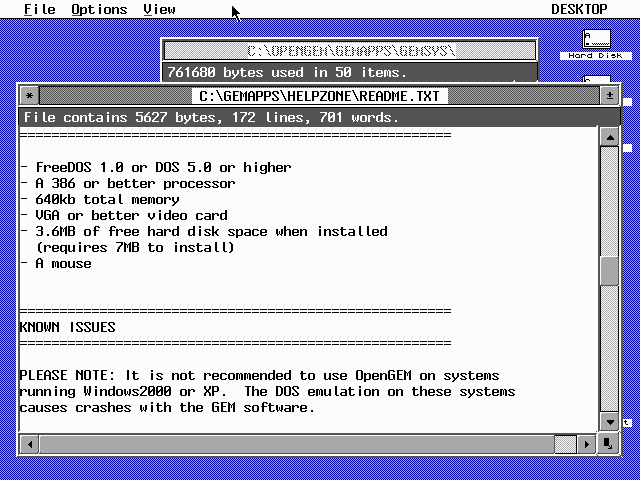Looking at 1980's GEM in 2021
The desktop environment from Gary Kildall's Digital Research is worth admiring... even more than 30 years later.
Back in the 1980s, GEM (from Gary Kildall’s Digital Research) was one of the graphical desktop alternatives to Apple’s Macintosh System software and Microsoft Windows. One that was specifically designed to run on DOS compatible systems (similar to early Windows in that regard).
But, outside of a port to the Atari ST line (where GEM was the default UI), most computer users never really got a chance to use it. By the time 1990 hit… GEM on DOS PCs was already on its deathbed (having been relegated to being nothing more than the UI framework for running ViewMAX — a file manager that shipped with DR DOS).
Here we are. More than 30 years later.
GEM has long since been open sourced — called “FreeGEM” — with the full source code available under the GPL. There’s even a “distribution” of FreeGEM called “OpenGEM”.
You can download the binaries for OpenGEM and run it on just about any DOS you can imagine — FreeDOS, MS-DOS (or DR DOS or PC-DOS) in a virtual machine, or even DOSBox.
Do so, and this is what you’ll be greeted with:
The usability is instantly recognizable. Very “Mac-like” in many ways. Menu bar across the top. Drive icons default to the top right. Double click on icons of drives and folders to open those in windows. Double click on software to run them.
Easy-peasy.
GEM was single tasking. One application at a time (like early Macintoshes and iPhones).
A large portion of the user experience and look is customizable. Colors, UI element styles… the works. There’s even a built-in editor for creating system icons and customizing your mouse pointer (which you can make look like whatever you wish).
I love it when systems offer that level of customizability. To truly make a computer your own. I find it odd when operating systems don’t allow customization like this.
This general look and feel was possible (more or less) back in the late 1980s. We’re talking before Windows 3.1 by a good couple of years. Around the same time as Windows 2.0.
There are certainly limitations to running GEM nowadays (in 2021). Only one application at a time. Extremely limited number of existing software packages. Equally limited options for developing new software for the system.
But you can see the potential quite clearly. A clean, lightweight, customizable system. Would have been interesting to see where Digital Research might have been able to take it if things had gone differently in the industry.
After GEM was axed…
By 1993, Atari (which had the rights to continue development of GEM independently of Digital Research) released a multitasking version of GEM known as “Multi TOS”.
Multitasking. Color icons. More software specifically developed for the Atari-based GEM than for PC GEM. Quite powerful for the time. And a good indicator of where GEM development could have gone.
Fun side note: That multitasking, Atari GEM (“Multi TOS”) was originally started as personal project by a guy named Eric Smith. His goal was to bring some of the GNU toolchain to the Atari ST. To make it easier for himself, he developed an extension to the existing Atari TOS that added some UNIX-y functionality. He named this component “MiNT” (which stands for “Mint is Not TOS”). Atari hired Eric, brought “MiNT” in house, and eventually released the result as “Multi TOS”… the new default system.










